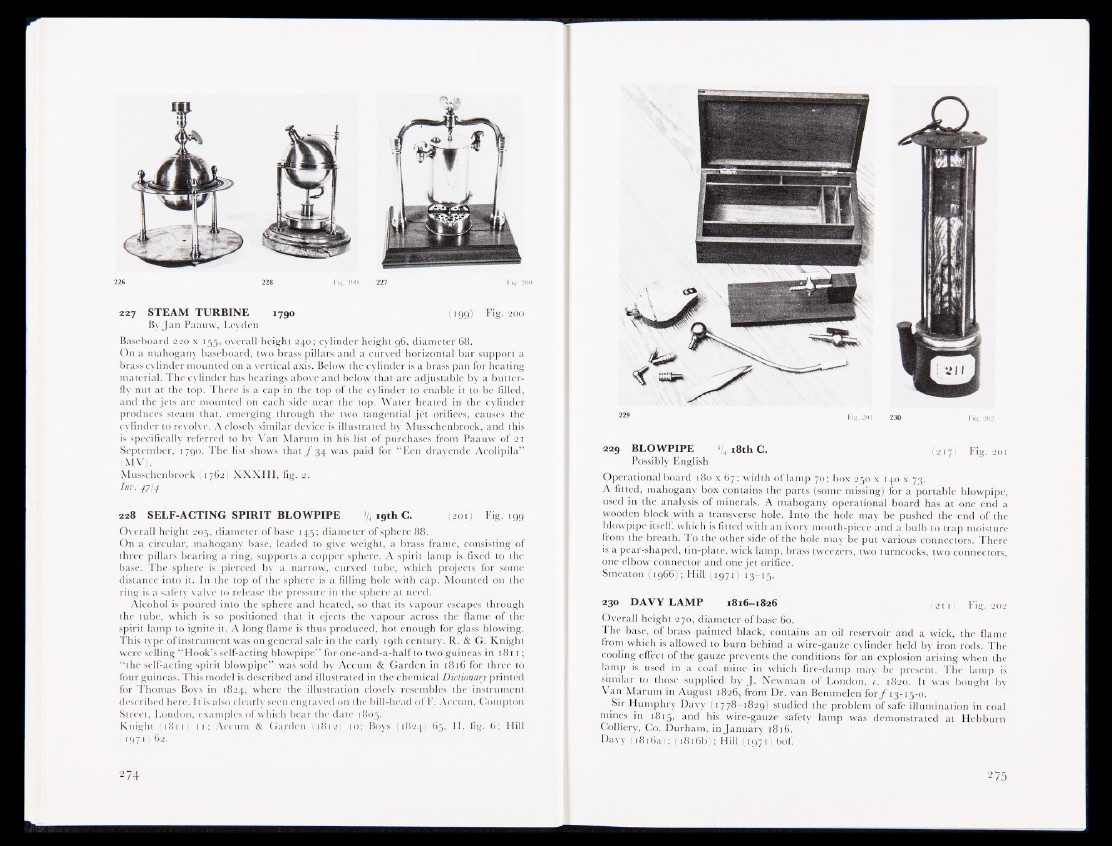
227 STEAM TURBINE 1790 (199) Fig. 200
By Jan Paauw, Leyden
Baseboard 220 x 155, overall height 240; cylinder height 96, diameter 68.
On a mahogany baseboard, two brass pillars and a curved horizontal bar support a
brass cylinder mounted on a vertical axis. Below the cylinder is a brass pan for heating
material. The cylinder has bearings above and below that are adjustable by a butterfly
nut at the top. There is a cap in the top of the cylinder to enable it to be filled,
and the jets are mounted on each side near the top. Water heated in the cylinder
produces steam that, emerging through the two tangential jet orifices, causes the
cylinder to revolve. A closely similar device is illustrated by Musschenbroek, and this
is specifically referred to by Van Marum in his list of purchases from Paauw of 21
September, 1790. The list shows that ƒ 34 was paid for “Een drayende Aeolipila”
(MV).
Musschenbroek (1762) XXXIII, fig. 2.
Inv. 47I4
228 SELF-ACTING SPIRIT BLOWPIPE f/4 19th C. (201) Fig. 199
Overall height 205, diameter of base 145; diameter of sphere 88.
On a circular, mahogany base, leaded to give weight, a brass frame, consisting of
three pillars bearing a ring, supports a copper sphere. A spirit lamp is fixed to the
base. The sphere is pierced by a narrow, curved tube, which projects for some
distance into it. In the top of the sphere is a filling hole with cap. Mounted on the
ring is a safety valve to release the pressure in the sphere at need.
Alcohol is poured into the sphere and heated, so that its vapour escapes through
the tube, which is so positioned that it ejects the vapour across the flame of the
spirit lamp to ignite it. A long flame is thus produced, hot enough for glass blowing.
This type ofinstrument was on general sale in the early 19th century. R. & G. Knight
were selling “ Hook’s self-acting blowpipe” for one-and-a-half to two guineas in 1811 ;
“ the self-acting spirit blowpipe” was sold by Accum & Garden in 1816 for three to
four guineas. This model is described and illustrated in the chemical Dictionary printed
for Thomas Boys in 1824, where the illustration closely resembles the instrument
described here. 11 is also clearly seen engraved on the bill-head of F. Accum, Compton
Street, London, examples of which bear the date 1805.
Knight ( 1811 ) 11 ; Accum & Garden (1812) 10; Boys (1824) 65, II, fig. 6; Hill
(1971) 62.
229 l'is . 201 230 I'ig. 202
229 BLOWPIPE 4/4 18th C. (217) Fig. 201
Possibly English
Operational board 180 x 67; width of lamp 70; box 250 x 140 x 73.
A fitted, mahogany box contains the parts (some missing) for a portable blowpipe,
used in the analysis of minerals. A mahogany operational board has at one end a
wooden block with a transverse hole. Into the hole may be pushed the end of the
blowpipe itself, which is fitted with an ivory mouth-piece and a bulb to trap moisture
from the breath. To the other side of the hole may be put various connectors. There
is a pear-shaped, tin-plate, wick lamp, brass tweezers, two turncocks, two connectors,
one elbow connector and one jet orifice.
Smeaton (1966); Hill (1971) 13—15.
230 DAVY LAMP 1816-1826 (211) Fig. 202
Overall height 270, diameter of base 60.
The base, of brass painted black, contains an oil reservoir and a wick, the flame
from which is allowed to burn behind a wire-gauze cylinder held by iron rods. The
cooling effect of the gauze prevents the conditions for an explosion arising when the
lamp is used in a coal mine in which fire-damp may be present. The lamp is
similar to those supplied by J. Newman of London, c. 1820. It was bought by
Van Marum in August 1826, from Dr. van Bemmelen for ƒ 13-15-0.
Sir Humphry Davy ;|Ji 778—1829) studied the problem of safe illumination in coal
mines in 1815, and his wire-gauze safety lamp was demonstrated at Hebburn
Colliery, Co. Durham, in January 1816.
Davy ,('i 816a.); (1816b); Hill (1971) 6of.